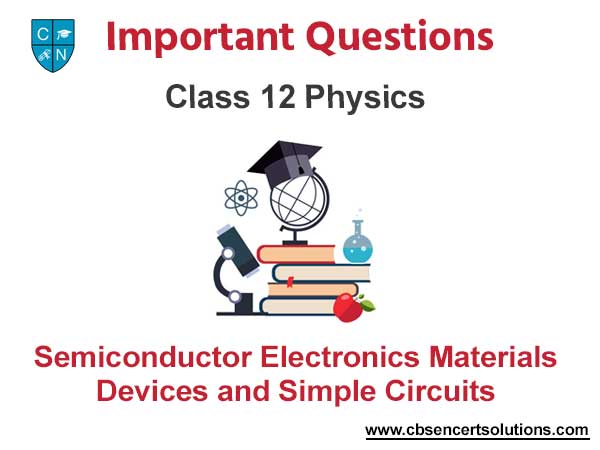Students can read the important questions given below for Semiconductor Electronics Materials Devices and Simple Circuits Class 12 Physics. All Semiconductor Electronics Materials Devices and Simple Circuits Class 12 Notes and questions with solutions have been prepared based on the latest syllabus and examination guidelines issued by CBSE, NCERT and KVS. You should read all notes provided by us and Class 12 Physics Important Questions provided for all chapters to get better marks in examinations. Physics Question Bank Class 12 is available on our website for free download in PDF.
Important Questions of Semiconductor Electronics Materials Devices and Simple Circuits Class 12
Question. Which of the following statements is not true?
a. The resistance of intrinsic semiconductor decreases with increase of temperature.
b. Doping pures Si with trivalent impurities gives p- type semiconductors.
c. The majority charges in n- type semiconductors are holes.
d. A p-n junction can act as semiconductor diode.
Answer
C
Question. The depletion region of the zener diode is
a. Thick
b. Normal
c. Very thin
d. Very thick
Answer
C
Question. What is the level of dopping in zener diode?
a. Lightly dopped
b. Heavily dopped
c. Moderately dopped
d. No dopping
Answer
B
Question. The impurity atoms with which pure Si should be doped to make a p- type semiconductor is
a. Phosphorus
b. Boron
c. Arsenic
d. Antimony
Answer
B
Question. Holes are majority charge carriers in
a. Intrinsic semiconductors.
b. Ionic Solids
c. p- type semiconductors
d. Metals
Answer
C
Question. The energy band gap is maximum in
a. Metals
b. Superconductors
c. Insulators
d. Semiconductors
Answer
C
Question. The number of majority carriers crossing the junction of diode depends primarily on the
a. Concentration of doping impurities
b. Magnitude of potential barriers
c. Magnitude of the forward bias voltage
d. Rate of thermal generation of electron –hole pairs
Answer
D
Question. Hole is
a. Antiparticle of electron
b. A vacancy created when an electron leaves covalent bond
c. Absence of free electrons
d. An artificially created particle.
Answer
B
Question. In the depletion region of a diode
a. There are no mobile charges
b. Equal number of holes and electrons exist, making the region neutral.
c. Recombination of holes and electrons has taken place.
d. Immobile charge ions exist.
Answer
D
Question. When a p-n junction diode is reverse biased then
a. No Current flows
b. The depletion reason is increased
c. The depletion reason is reduced
d. Height of potential barrier is reduced
Answer
B
Question . Diode is used as
a. Oscillator
b. Amplifier
c. Rectifier
d. Modulator
Answer
C
Question. At absolute zero, Si acts as
a. Non- metal
b. Metal
c. Insulator
d. None of these
Answer
C
Question. In the middle of depletion layer of reverse biased p- n junction, the
a. Electric field is zero
b. Potential is zero
c. Potential is maximum
d. Electric field is maximum
Answer
C
Question.Which one statement is incorrect?
a. Diode is used as rectifier
b. Diode is used as half wave rectifier
c. Diode is used as Amplifier
d. Diode is used as full wave rectifier
Answer
C
Question. Zener diode is mostly used as
a. Half wave rectifier
b. Full wave rectifier
c. Voltage regulator
d. LED
Answer
C
Question. Zener diode is designed to specially work in which region without getting damaged ?
a. Active region
b. Break down region
c. Forward Biased
d. Reverse biased
Answer
B


